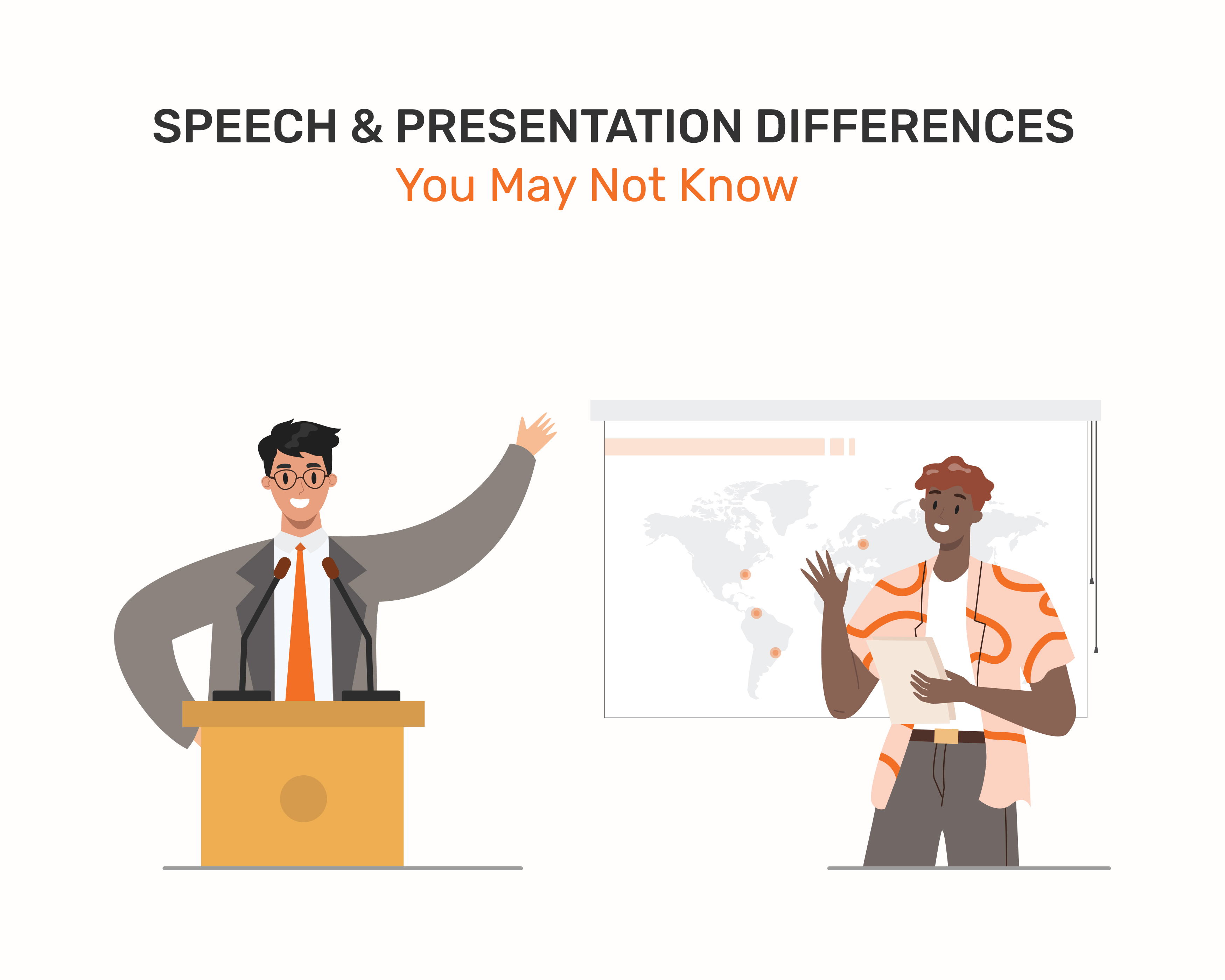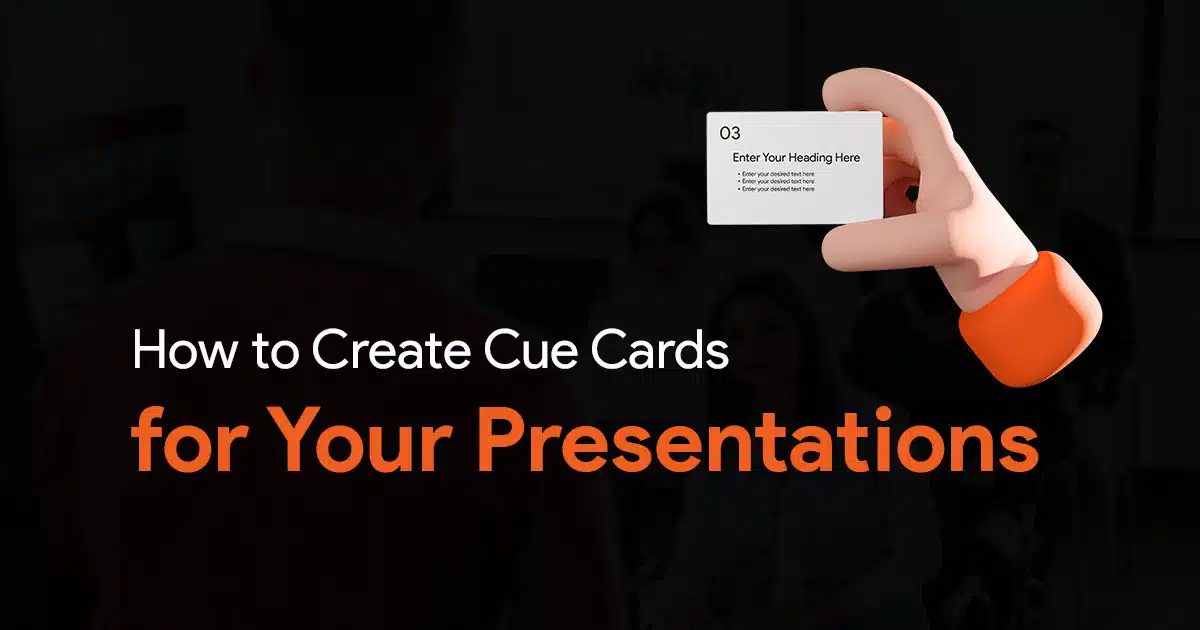The Differences Between Speech and Presentation You May Not Know

Have you ever thought about the difference between speech and presentation? It might seem like those things look the same, but you should understand the huge differences between them. And once you know it, you will excel at both of them.
Many people still seem to confuse those two things and use the words interchangeably without knowing they are different. So, for example, we checked the meaning of those words in the Merriam-Webster dictionary and discovered two different meanings.
While speech is described as “a formal talk that a person gives to an audience,” a presentation is “a meeting at which something, especially a new product or idea, or piece of work, is shown to a group of people.”
From the definition alone, you can see that one says ‘talk’ and the other says ‘shown.’ But what’s the meaning of those words? To make things clearer, here are the differences between speech and presentation.
Memorizing the material
The first difference between speech and presentation is the way you present the information. Even though they look the same, you indeed feel the differences between speech and presentation by your own experience.
Let’s start with the most subtle difference between speech and presentation: how we present the material based on what we memorize. We tend to make everything so clear to the audience during presentations, which requires a lot of memorization.
The same thing may apply during speeches, but because speeches are not made to tell every single detail of the thing that you want to explain, you might not need to memorize every detail in the fabric.
Fact is, you may even expand your topic during speeches, but not in presentation. So, for example, during your speech on the importance of trees, you may expand to include what’s happening to our environment.
However, if you talk about a specific topic during a presentation, you may want to put further details in it instead of expanding the topic. So, during a presentation, you may memorize more details.
While in speeches, you may memorize the related topics that can support your point. In this case, we may talk about the second difference between those things. In this case, we may speak of the second difference between those things.
Visual aids
There is a reason why both of them use visual aids, and we will show you the difference between each use. The first is about speech. During a lesson, as mentioned above, you need to master your topic to the rate that you can expand it further.
What’s the connection between that and visual aids? Speeches mainly use visual aids to help themselves remember the points they want to talk about. While in presentation, the use of visual aids is to help the audiences understand.
In this case, we can expand the difference between the two. While in speeches, the visual aid design is not that important, the design in presentation is highly regarded. Not all lessons use visual aids because of that reason.
However, it doesn’t mean that visual aids are not crucial in speeches. One of the examples is a video or picture to tell the audience about a story. It surely will help the audience understand what you are talking about.
But in presentation, frequently, your visual aids alone can help the audiences understand what you are talking about. This is why your visual aids, such as PowerPoint presentations, need to be as clear as possible and as attractive as possible.
How visual aids help us in both speeches and presentations is intended to make the following difference clearer. And the next difference is how you share your vision about the topic you are delivering to the audience.
Sharing your vision
Have you ever seen a debate competition? In that competition, you might not see someone presenting their arguments with a well-designed PowerPoint presentation slide. Instead, they speak in front of the adjudicators and the audience with a small paper as a note.
We are not talking about the visual aids here, but we may look at the speaker’s notes. There, they mostly write only about the points that they want to deliver. But what’s the difference between the notes and the presentation handouts that we bring?
In presentation handouts, we also write notes, but our messages are primarily about what the speaker wants to highlight. However, the notes in a debate are about things they want to convince the audience.
Yes, the difference comes from how we speak about the topic in front of the audience. A speaker in speeches wants to convince the audience about their view or stance. They want to spread their vision about things.
While a presenter might not care much about their vision, speakers usually include the advantages, disadvantages, resolutions, plans, or generally accepted things. For example, take a look at how salesmen or saleswomen in their sales.
The ones who do speeches would tell inspiring, motivating, or heartwarming things to sell their products. While the ones presenting their sales would focus more on the advantages, disadvantages, or their products’ unique features.
Preparation time between speech and presentation
This one difference is exciting and a little bit controversial. Why? Because what we want to tell you might shake your view about the differences between those two. What is it? It is about how you prepare for the upcoming speech/presentation.
Supported by Art of Presentation, it says that presenting is a well-prepared action. So it would help if you worked very well in preparing the things you want to deliver to the audience to make sure you can give as well as possible.
You might need to fact-check everything, create PowerPoint presentation slides, getting things correlated with one another. You might also at least practice how you will present to make sure you will nail the presentation.
But with speeches, you may not need to practice anything or prepare for the things you want to deliver. It is because speeches are more like art than just telling people about things. See how we differentiate an excellent orator from a bad one?
Good orators may talk about things as they will, and people will still get their point. However, some good people may not even prepare anything except their own story created spontaneously in the venue.
The difference in stories to deliver between speech and presentation
From the distinction above, you might be able to guess what’s the following difference. While speeches are more about the speaker’s creativity, preservations are more about how you process information and deliver almost the same thing in a descriptive way.
A good orator needs to have a million ways to deliver the information to the audience. On the other hand, a good presenter needs to find the best descriptive way to show the presentation without getting their stories out of context.
You can train yourself into a good orator by collecting exciting stories and experiences to tell your future audiences. This way, you can show a million stories based on things you have collected in your speeches and get the audience to understand your points.
On the other hand, you can train yourself into a good presenter by trial and error in presenting. Then, later on, you can choose the best descriptive way to make them get your points and always use that in your future presentations to get the same result.
That is because your presentation is helped a lot by the visual aids we mentioned above. In addition, you can always correlate your presentation with visual aids.
Detailed information versus convincing words
If you are presenting something, you will primarily use more accurate data. And when someday you are giving a speech to other people, you mostly will tell them stories you created or experienced.
Again, the way we speak in a presentation is different from how we say in a speech. We don’t need to make things too strict in a lesson, but we need to be as professional as possible during a presentation.
But looking deeper into the reasons, we have different ‘languages’ in delivering those things. For example, while presenting something, we tend to give detailed information without trying to make up words or explanations.
Things are different with speeches when we can be as creative in our stories as possible. In this case, our words do not need to be very detailed. The reason for that is because our primary mission is to convince the audiences no matter what.
Now, can you imagine a huge gap between presenting descriptively with detailed information about the thing you want to talk about and how to make a convincing story no matter what? Yes, that huge gap is going to tell you the difference between speech and presentation.
Closing
Those are the differences we can easily spot between speech and presentation. We hope it will help you understand what you want to do next before doing any of those things.
Author bio:
This article is written by Ulfah, an SEO & Content Manager, and is currently working for RRGraph Design. Say hello through her LinkedIn.


